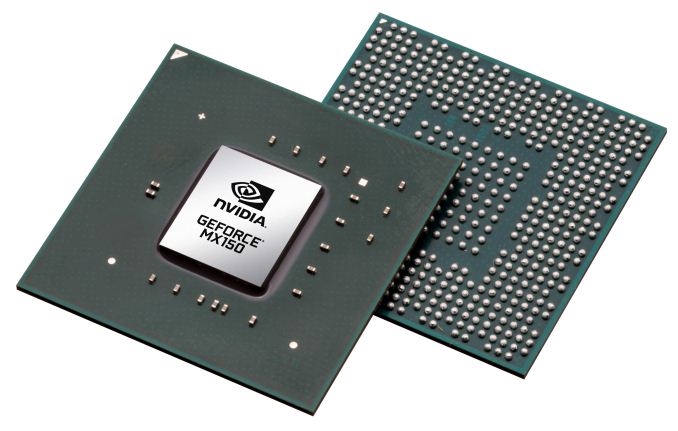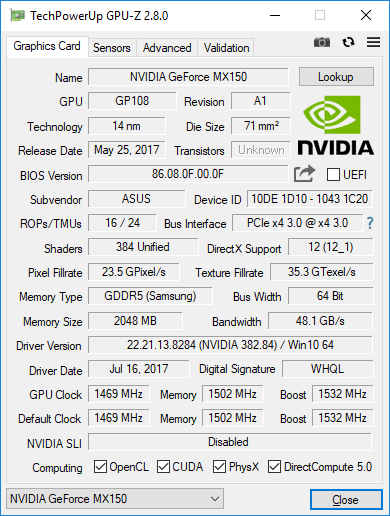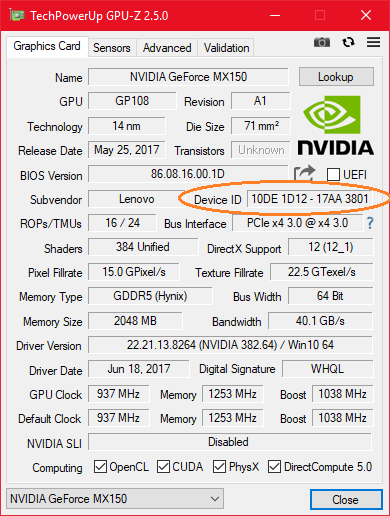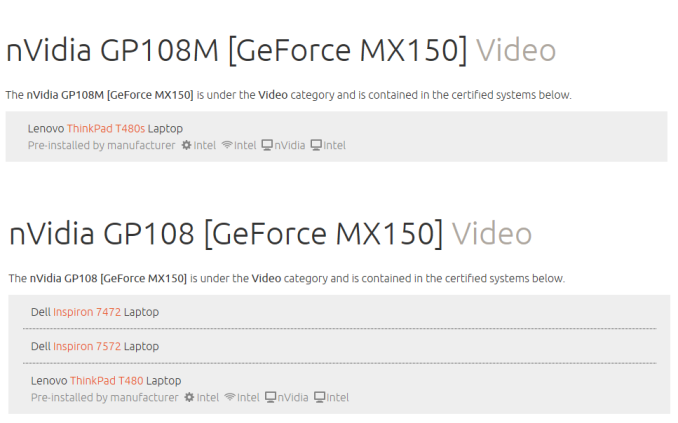NVIDIA Silently Rolls Out Slower, Lower TDP GeForce MX150 for Ultrabooks
by Nate Oh on March 23, 2018 2:00 PM EST
This week, Notebookcheck reported their findings of a second version of the GeForce MX150 – the newest version sporting lower base, boost, and memory clockspeeds versus the original SKU. Annoyingly however, these two versions are not being differentiated in advertising by NVIDIA or by OEMs.
Diving into matters, it looks like this second MX150 is designed to be a lower performing, lower TDP version for smaller ultrabooks. Notebookcheck cited their GPU-Z results as showing two different PCI IDs, comparing the standard ‘1D10’ and variant ‘1D12’ to find a default clockspeed difference of 36% for base, 17% for memory, and 32% for boost. In turn, they cited 3DMark tests in estimating a 20 to 25% performance drop for the “1D12’ MX150, where a number of 13 inch ultrabooks had this variant but was not disclosed.

 Notebookcheck's GPU-Z reports, with standard '1D10' N17S-G1-A1 GeForce MX150 in the Zenbook UX430UN (left), and slower '1D12' N17S-LG-A1 GeForce MX150 in the IdeaPad 320s-13kbr (right)
Notebookcheck's GPU-Z reports, with standard '1D10' N17S-G1-A1 GeForce MX150 in the Zenbook UX430UN (left), and slower '1D12' N17S-LG-A1 GeForce MX150 in the IdeaPad 320s-13kbr (right)
Further investigation on our part does reveal that there is a documented understanding that they are different parts, at least from an OEM perspective. By way of the official Ubuntu Certified hardware database, PCI ID ‘1D10’ is documented as the ‘GP108’ MX150 variant of the ThinkPad T480, while ‘1D12’ is recorded as the ‘GP108M’ variant of the ThinkPad T480s. In this case, although ‘GP108’ and ‘GP108M’ may not be NVIDIA’s own terminology, the Ubuntu Certified process involves OEMs directly working with Canonical to test their hardware. Canonical’s differentiation strongly implies that the OEMs are aware of MX150 variant.
Continuing with the ThinkPad as the prime case study, each product page has no indication of any difference in discrete graphics adapters, though the T480s is the thinner laptop variant. And while different cooling designs of laptops will change the exact clocks of the same GPU, the different PCI IDs and certifications suggest that this a vendor-side variant undisclosed to consumers.
In total, Notebookcheck also noted the presence of the slower MX150 in the ZenBook UX331UN, ZenBook UX331UA, Mi Notebook Air 13.3, Envy 13, and IdeaPad 320s. And a cursory look at The PCI ID Repository again corroborates the idea of the two corresponding ‘1D10’ and ‘1D12’ PCI IDs, with a GP108 Quadro variant in the P500. From the January/February dates of the Ubuntu certification and PCI ID Repository entries, we can say this development has been ongoing for several months at the least.
The engineering practicality isn’t in doubt here – constrained cooling designs of ultra-thin laptops necessitate lower discrete GPU clocks – but it appears that consumers were not notified of an explicit product difference. This is as juxtaposed with the OEM situation, where OEMs and/or NVIDIA did explicitly communicate to Canonical for the purposes of Ubuntu hardware certification. And while it is true that mobile and low-end (and especially mobile low-end) GPUs receive very little in terms of public documentation or vendor disclosure, this is why a lack of product transparency is a losing situation all around.
Though we only came across the Ubuntu Certified database entries after reaching out, NVIDIA has declined to comment on the matter. However, with what we have collated, there seems to be little reason to doubt the undisclosed slower MX150 variant.











40 Comments
View All Comments
PeachNCream - Friday, March 23, 2018 - link
It's good to see some work being put into getting power and cooling reduced in Pascal GPUs which may have upped the performance bar a little in exchange for higher TDPs across all performance categories, but it might be too little and too late. The lack of consumer transparency is a minor problem as well because NVIDIA could be advertising the change and encouraging OEMs to offer the newer, cooler version in full sized notebooks instead of just utility-limited ultrabooks as well so consumers could get a quieter, better laptop without giving up discrete graphics as long as a sacrifice in performance is the understood cost. It overall seems like NVIDIA is giving up potential sales, but I do continue to hope they'll reach further up the GPU mobile GPU stack with future version and maybe look at doing something about their desktop chips as well.plopke - Friday, March 23, 2018 - link
I strongly disagree with "The lack of consumer transparency is a minor problem" , I could have been easily fixed MX150-E for energy efficiency , now you get NO CLUE what you buy? And those numbers make it look like the performance difference might be big enough for people to care.Major manufactures/Online stores already lack details or correct specifications , the cynical side of me is saying just call everything a MX150 , who care if it runs 10-30% faster ...
Morawka - Saturday, March 24, 2018 - link
Look at the TDP of your chassis, that should tell you which version you'll get. I'm wondering if you can simply flash the higher TDP bioses onto these to unlock their full potential.Vayra - Sunday, March 25, 2018 - link
'Should'... who are we really trusting that it truly is in the end? Nvidia? The OEM? It really is anyone's guess and that is bad.Alexvrb - Sunday, March 25, 2018 - link
Do you currently publish a list of "chassis TDPs" we can peruse? Gosh golly gee that's a swell solution to the problem. Surely the average consumer will know to stop and search Morawka's Database of Chassis TDPs while standing at Best Buy, to know what they're getting.OEMs and their sheisty marketing.
PeachNCream - Monday, March 26, 2018 - link
Sorry about the poor word choice causing confusion. When I say it's a minor problem, I meant to imply that it would be very easy to address by either NVIDIA changing the GPU model number or by the OEMs very clearly showing the lower power MX150's specifications on boxes and in marketing specs. I wasn't trying to reduce the significance of the performance differences between the two identically named graphics processors. That concern got lost amid my excitement about a heat-reduced GPU finally making its way into laptops.SleepyFE - Friday, March 30, 2018 - link
WHAT THE HELL ARE YOU ON ABOUT!! HEAT REDUCED (read with outraged intonation)!! It's straight up performance reduced! And yes the heat does reduce as well when you decrease performance, but heat reduced would imply no performance penalty. I am glad you feel free enough to voice your opinion. Keep it up. But know that it was noted as a clumsy attempt at mitigating NVIDIA's shenanigans. Since it's the first comment one might even wonder if it's by a PR firm: "It's not a degredation, your laptop will be cooler and quieter." (The last sentence is the gist of the first comment and not my opinion)Glock24 - Friday, March 23, 2018 - link
This is nothing new. In the past there have been mobile GPUs with very different performance characteristics but same name. On the top of my head I remember the mobile Geforce 7600 had several variations, some with less pipelines, some with 128 bit memory bits, others with 64bit memory bus, some GDDR2, some GDDR3 and so on. But all were called Geforce 7600. And there were other similar cases, I just don't remember the specific models.willis936 - Friday, March 23, 2018 - link
I too remember multiple instances of this.I feel like this should break some law that incurs a healthy fine, if it doesn't already.
shabby - Friday, March 23, 2018 - link
I think it's the oem's responsibility to inform customers that the gpu is slower, they know what they're getting from nVidia.